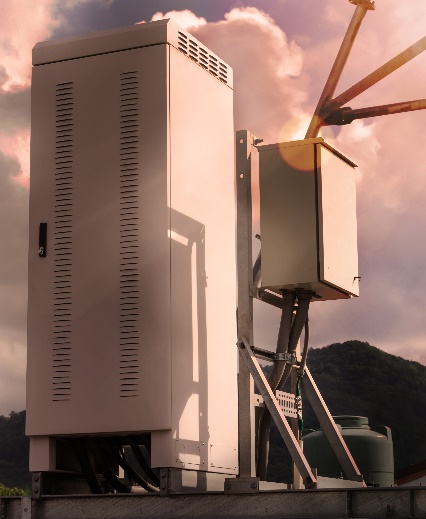

Computing on the Edge: Other Design Considerations for the Edge – Part 1
Fri, 13 Jan 2023 19:46:50 -0000
|Read Time: 0 minutes
In past blogs, the requirements for NEBS Level 3 certifications were addressed, with even higher demands depending on the Outside Plant (OSP) installation requirements. Now, additional design considerations need to be considered, to create a hardware solution that is not only going to survive the environment at the edge, but provides a platform that can be effectively deployed to the edge.
Ruggedized Chassis Design
The first design consideration that we’ll cover for an Edge Server is the Ruggedized Chassis. This is certainly a chassis that can stand up to the demands of Seismic Zone 4 testing and can also withstand impacts, drops, and vibration, right?
Not necessarily.
While earthquakes are violent, demanding, but relatively short-duration events, the shock and vibration profile can differ significantly when the server is taken out from under the Cell Tower. We are talking beyond the base of the tower, and to edge environments that might be encountered in Private Wireless or Multi-Access Edge Compute (MEC) deployments. Some vibration and shock impacts are tested in GR-63-Core, under test criteria for Transportation and Packaging, but ruggedized designs Figure 1. Portable Edge Compute Platforms need to go beyond this level of testing.
Figure 1. Portable Edge Compute Platforms need to go beyond this level of testing.
For example, the need for ruggedized servers in mining or military environments, where setting up compute can be more temporary in nature and often includes the use of portable cases, such as Pelican Cases. These cases are subject to environmental stresses and can require ruggedized rails and upgraded mounting brackets on the chassis for those rails. For longer-lasting deployments, enclosures can be less than ideal and require all the requirements of a GR-3108 Class 2 device and perhaps some additional considerations.
Dell Technologies also tests our Ruggedized (XR-series) Servers to MIL-STD-810 and Marine testing specifications. In general, MIL-STD-810 temperature requirements are aligned with GR-63-CORE on the high side but test operationally down to -57C (-70F) on the low side. This reflects some extreme parts of the world where the military is expected to operate. But MIL-STD-810 also covers land, sea, and air deployments. This means that non-operational (shipping) criteria is much more in-depth, as are acceleration, shock, and vibration. Criteria includes scenarios, such as crash survivability, where the server can be exposed to up to 40Gs of acceleration. Of course, this tests not only the server, but the enclosure and mounting rails used in testing.
So why have I detoured onto MIL-STD and Marine testing? For one, it’s interesting in the extreme “dynamic” testing requirements that are not seen in NEBS. Secondly, creating a server that is survivable in MIL-STD and Marine environments is only complementary to NEBS and creates an even more durable product that has applications beyond the Cellular Network.
Server Form Factor
 Figure 2. Typical Short Depth Cell Site EnclosureAnother key factor in chassis design for the edge is the form factor. This involves understanding the physical deployment scenarios and legacy environments, leading to a server form factor that can be installed in existing enclosures without the need for major infrastructure improvements. For servers, 19 inch rackmount or 2 post mounting is common, with 1U or 2U heights. But the key driver in the chassis design for compatibility with legacy telecom environments is short depth.
Figure 2. Typical Short Depth Cell Site EnclosureAnother key factor in chassis design for the edge is the form factor. This involves understanding the physical deployment scenarios and legacy environments, leading to a server form factor that can be installed in existing enclosures without the need for major infrastructure improvements. For servers, 19 inch rackmount or 2 post mounting is common, with 1U or 2U heights. But the key driver in the chassis design for compatibility with legacy telecom environments is short depth.
Server depth is not something covered by NEBS, but supplemental documentation created by the Telecoms, and typically reflected in RFPs, define the depth required for installation into Legacy Environments. For instance, AT&T’s Network Equipment Power, Grounding, Environmental, and Physical Design Requirements document states that “newer technology” deployed to a 2 post rack, which certainly applies to deployments like vRAN and MEC, “shall not” exceed 24 inches (609mm) in depth. This disqualifies most traditional rackmount servers.
The key is deployment flexibility. Edge Compute should be able to be mounted anywhere and adapt to the constraints of the deployment environment. For instance, in a space-constrained location, front maintenance is a needed design requirement. Often these servers will be installed close to a wall or mounted in a cabinet with no rear access. In addition, supporting reversible airflow can allow the server to adapt to the cooling infrastructure (if any) already installed.
Conclusion
While NEBS requirements focus on Environmental and Electrical Testing, ultimately the design needs to consider the target deployment environment and meet the installation requirements of the targeted edge locations.


